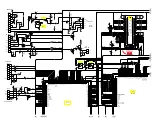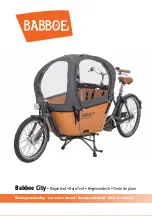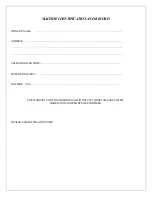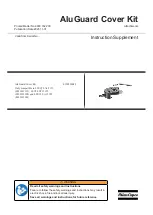
8
17. CHARGING BATTERY (CONTINUED)
Charging Sequence
• Ensure that the battery and charger cables have no damage prior to connecting.
• Connect the charger to the battery charging ports in plugs.
The battery will either
have a SINGLE or DUAL charging port, depending on the part number of
battery and application charge rate.
• Once a charge cable is connected, the traction contactor will open removing power
from the truck for drive away protection.
• If battery is OFF the charger will automatically awake the battery and begin to charge.
• Charging will begin after the CAN communication has started between the battery
and the charger, which occurs when the charge cable with the CAN connector is
connected. The optimal charge current will be determined automatically based on
the battery conditions (SOC, temperature, etc.) and charger conditions (temperature,
charger size). The charge level will dynamically change during the charging process
ensuring fast charging and ensuring optimal lifetime of the product. If the BMS
detects a fault condition, the charging will stop.
• If required to stop charging prior to completing charge, such as during Opportunity
Charging, press the ON/OFF button on the charger prior to disconnecting.
The
battery must not be disconnected while still being charged by the charger.
• After a full charge cycle is complete, the charger screen will indicate that charging is
complete. At this point it is no longer supplying current to the battery and, the charge
plug(s) should be disconnected from the battery. After completely disconnecting the
charge plug(s) the battery will then automatically open the charge path and close the
traction path, which will supply power to the truck.
18. TRANSPORT
Because of their inherent stored energy and flammability, Li-ion batteries are considered
“Dangerous Goods” and must be transported in accordance with all regulations. The
classification for the battery is Class 9 according to the Recommendations on the
Transport of Dangerous Goods, Manual of Tests and Criteria. Anyone shipping batteries
must be trained as required by local regulations in order to ship hazardous goods.
UN “Recommendations on the Transport of Dangerous Goods, Manual of Tests and
Criteria”, chapter 38.3 (known as UN38.3) has been applied and product tested to UN
38.3 with test summaries available upon request.
Damaged batteries must be transported based on all applicable regulations for
damaged Lithium-ion batteries. These requirements are in addition to the standard UN
38.3 criteria. Contact EnerSys
®
for assessment and support in transporting damaged
batteries.
For further transport and regulatory information (USA and EU; classifications and
labeling) refer to Lithium-ion Battery (Module) SDS: 829515 instructions or regulations by
the International Civil Aviation Organization (ICAO), International Air Transport Association
(IATA), International Maritime Dangerous Goods (IMDG), Convention concerning the
Carriage of Goods by Rail (CIM), and Annex A: International Regulations concerning
the Carriage of Dangerous Goods by Rail (RID) codes. Other laws and regulatory
requirements may apply depending upon a given location. It is required for all persons
shipping to become familiar with the application regulations.
19. STORAGE
The battery must be stored in a dry environment away from fire, sparks, and heat.
The allowable storage temperatures are -40°F (-40°C) to 140°F (60°C).
Storage area must be compliant with local fire, safety and building regulations for
Lithium-ion batteries and in accordance with the building’s insurance.
Battery must only be stored in upright position (comparable to the installation in the
vehicle) with all service lids properly attached.
During storage, it is not necessary to disconnect the power connection between the
industrial truck and battery. However, it is highly recommended to disconnect the truck
and battery communication connector.
19. STORAGE (CONTINUED)
For storage of greater than one month precautions must be taken to ensure the battery
is not deeply discharged. The pack must be stored at 30%-70% SOC. In addition,
processes and recharge methodology must be in place to ensure that battery does not
discharge to 5% SOC in storage. It is recommended to turn the pack on and check the
SOC every six months and recharge to greater than 30% SOC if the SOC has dropped
below 30% SOC. Maximum temperature of long term storage location should be less
than 95°F (35°C).
20. SERVICE AND MAINTENANCE
The battery has been designed to be virtually maintenance-free. However, external
cabling, connectors, etc. (including operator interfaces) must be examined periodically as
required to ensure there is no damage to such parts. If any of these parts are damaged
or show signs of serious wear, they need to be replaced. Please contact your local
EnerSys
®
service center for all repairs and replacements. All repairs must be done by an
EnerSys technician trained on Lithium-ion products.
All power cables must be checked every time the battery has been exposed to any type
of stress, whether it be overvoltage, overcurrent, or any mechanical stresses such as
crushing.
21. DISMANTLING
Dismantling of the battery is not authorized except by qualified EnerSys personnel due
to the numerous hazards involved with dismantling a battery (e.g. recycling, service).
22. DISPOSAL AND RECYCLING
NOTE
: Disposal must be in accordance with local regulations. Do not dismantle,
incinerate, or crush battery systems.
In case of irreparable failure or end of life, the battery must be taken out of operation
in a controlled manner (contact EnerSys for more details). The battery should not
be dismantled by the customer. Specialized handling and recycling are required for
damaged products. Do not dispose of waste batteries as unsorted municipal waste.
EnerSys, in line with Local Regulations, will accept NexSys
®
iON products at specific
facilities for disposal. Contact your local EnerSys Representative for specific recycling
instructions per region.
23. TROUBLESHOOTING
If the battery is inoperative, please be sure that the battery traction connector is either
connected to the vehicle, or in a Safe state to avoid potential damages or short circuits.
No Power to the Truck
Check the following items:
1. Press activation button
2. No active errors are listed by the display. If “Lockout” is displayed, contact EnerSys
Service.
3. Ensure the battery is turned on (Refer to Section 14: Operator Interfaces)
4. Power cycle the battery.
5. Ensure charger is not plugged in as power to the truck is turned off in order to
prevent drive away from the charger.
6. Inspect power cables to truck to ensure there is no damage.
7. In case of an active error, review error ID checklist below.
Содержание NexSys
Страница 1: ...Owner s Manual www enersys com ADVANCED LITHIUM ION TECHNOLOGY Li ion TECHNOLOGY...
Страница 11: ...11 NOTES...






























